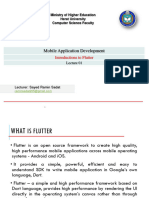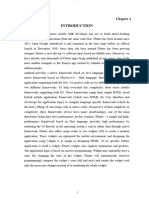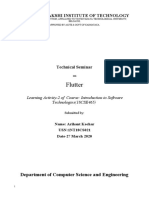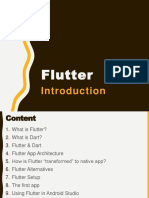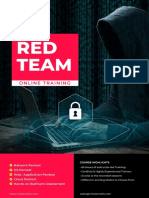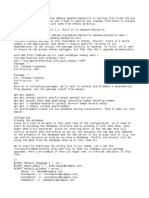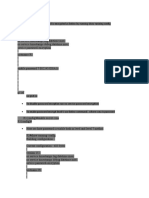Chapter I
Introduction to Flutter Framework
&
Page 4/126
�I. Introduction to Flutter & Dart
I. Brief History of Flutter & Dart
Flutter
Flutter is an open-source UI software development kit created
by Google. It is used to develop applications for Android, iOS, Windows,
Mac, Linux, Google Fuchsia.[5] and the web.
The first version of Flutter was known as codename "Sky" and
ran on the Android operating system. It was unveiled at the
2015 Dart developer summit, with the stated intent of being able
to render consistently at 120 frames per second.
Note:
Dec 2018 => 1.0
Flutter's engine, written primarily in C++, provides low-
level rendering support using Google's Skia graphics library. Additionally, it
interfaces with platform-specific SDKs such as those provided
by Android and iOS.[8] The Flutter Engine is a portable runtime for hosting
Flutter applications. It implements Flutter's core libraries, including
animation and graphics, file and network I/O, accessibility support, plugin
architecture, and a Dart runtime and compile toolchain. Most developers will
interact with Flutter via the Flutter Framework, which provides a modern,
reactive framework, and a rich set of platform, layout and foundation
widgets.
Dart
General-purpose programming language developed by google in 2011.
It is a client optimized language used to build beautiful mobile and
Page 5/126
�web applications.Flutter apps are written in the Dart language and make use
of many of the language's more advanced features.
Flutter runs an debug in the Dart virtual machine, featuring a just-in-
time execution engine, allowing for "hot reload", with which modifications to
source files can be injected into a running application, which support
for stateful hot reload,
Release versions of Flutter apps are compiled with ahead-of-time
(AOT) compilation on both Android and iOS, making Flutter's high
performance on mobile devices possible.
Note:
UI design in Flutter involves using composition to assemble / create
"Widgets" from other Widgets. smaller Widgets are also made up of even
smaller Widgets, and each has a build() method of its own. This is how
Flutter makes use of Composition.
Complex widgets can be created by combining many simpler ones,
and an app is actually just the largest Widget of them all (often called
"MyApp"). The MyApp Widget contains all the other Widgets, which can
contain even smaller Widgets, and together they make up your app.
The Flutter framework contains two sets of widgets which conform to
specific design languages. Material Design widgets implement Google's
design language of the same name, and Cupertino widgets implement
Apple's Human Interface Guidelines iOS design
Dart => JIT ( Development )
=> AOT (Release )
Flutter => Dart 2.0
a garbage-collected,
object-oriented language with a sound type system and
type inferencing
Page 6/126
� II. How Flutter Work together with Dart
Alternatively : https://flutter.dev/docs/resources/technical-overview
https://flutter.dev/docs/resources/faq#what-is-inside-the-
flutter-sdk
Flutter App Flutter Frame Dart
(Written in Dart) Work
(Collective of
Dart Library)
Dart VM ( AOT ) Shell ( Canvas + Event )
Native
Page 7/126
� III.Anatomy of Flutter App
Everything inside of Flutter app is a widget and you build widgets upon
widgets just like Lego blocks on Lego blocks in order to create your app.
Scaffold => a blank screen for an app.
An AppBar => At the top, and this is a pre-built widget that
simply looks like an AppBar
Container, => Just a box and it's going to contain the content
of an app.
Column => Container that stack things vertically.
Row => Container that put things horizontally
( side by side)
Icon Widget => Use an icon widget to display predefined icon
Image Widget => Use to put image , located in assets folder
Network Image => User to put image for web
Page 8/126
�IV.Setup & Installation
Ref: https://flutter.dev/docs/get-started/install
I. Windows Installation Work Flow
1. Download Flutter SDK
eg: flutter_windows_v1.9.1+hotfix.4-stable.zip
2. Unzip and place contained folder flutter into c:/src
3. Edit Window’s environment variable name PATH
By typing ‘env’ in command prompt to load edit
Environment Variable window ,then select PATH entry and
click ‘Edit’ button Append the text ;C:/src/flutter/bin. And
save.
4. Test the Flutter Command
Load command prompt window and test the command
‘flutter’ .if command show flutter with its available option,
flutter installation is success
5. Checking Android Development Option
In command prompt, type ‘ flutter doctor’ to check any
additional requirement
6. Install Android SDK & Requirements
Flutter relies on a full installation of Android Studio to supply its
android platform dependencies and then you can write flutter apps
using variety of editors in later steps.
1. Download and Install android studio
1. https://developer.android.com/studio
2. Install Android respective SDK using Android Studio
Page 9/126
� ( File->Setting->Android SDK and check
required SDK Platform and apply )
This will install platform tool into default sdk
path:
C:\Users\USERNAME\AppData\Local\Android\Sdk
3. Create Android Emulator using existing sdk platform
and system image
7. Install Code Editor & Setup (Visual Studio Code )
1. Download Visual Studio Code Editor and install
https://code.visualstudio.com/
2. Run VS Code & Intall Flutter & Dart extension
OR View > Command Palette….
Type Install and select extension
Type Fluter in search field
Select Flutter and then click install
( Which wil install Dart Plug In too )
Page 10/126
�II. Mac Installation Work Flow
Ref: https://flutter.dev/docs/get-started/install
1. Download Flutter SDK
eg: flutter_windows_v1.9.1+hotfix.4-stable.zip
2. Unzip and place contained folder flutter into
1. USERNAME/src
3. Edit environment variable name PATH
4. Test the Flutter Command
Load terminal prompt window and test the command
‘flutter’ .if command show flutter with its available option,
flutter installation is success
5. Checking Android Development Option
Flutter relies on a full installation of Android Studio to supply its
android platform dependencies and then you can write flutter apps
using variety of editors in later steps.
6. Download and Install android studio
1. https://developer.android.com/studio
2. Install Android respective SDK using Android Studio
( File->Setting->Android SDK and check
required SDK Platform and apply )
This will install platform tool into default sdk
path:
Page 11/126
� /Users/YOURUSERNAME/Library/Android/sdk
3. Create Android Emulator using existing sdk platform
and system image
7. iOS Setup
Install the latest stable version of Xcode
Run command in terminal prompt:
sudo xcode-select --switch /Applications/Xcode.app/
Contents/Developer
This is the correct path for most cases, when you want to
use the latest version of Xcode. If you need to use a different
version, specify that path instead. Make sure the Xcode
license agreement is signed by either opening Xcode once
and confirming or running sudo xcodebuild -license from
the command line.
8. Install Code Editor & Setup (Visual Studio Code )
1. Download Visual Studio Code Editor and install
https://code.visualstudio.com/
2. Run VS Code & Intall Flutter & Dart extension
V. Creating Flutter App from Scratch
In VSC Terminal , browse to flutter SDK Path and run
following command to create new flutter app
> flutter create helloworld
this will create a new flutter app and its folder structure
browse VSCode to the newly created app’s folder: helloworld.
I. Simulation
In VSC Terminal , debug to test on simulator
Page 12/126
� Debug -> Start Debugging
On Android , virtual device is required to create and on iOS , a
simulator is load first before running if flutter is not able to detect
simulator or emulator or by running command :
> open -a Simulator
II. Device
Running on Android Device, no additional setup is required but
on iOS , need to setup developer account and install necessary tool ahead.
Ref: https://flutter.dev/docs/get-started/install/macos
VI.Scaffolding a flutter App
Modified main.dart to following as Simple Structure and run the app in
Android Emulator and iOS Simulator.
Page 13/126
� VII.Assets Management & the Pubspec File
open pubspec.yaml file with VSC and find the text ‘assets’ and
add the following line eg. You must create assets folder under project root
folder and add the actual file
# assets:
# - images/a_dot_burr.jpeg
# - images/a_dot_ham.jpeg
Or
assets:
- assets/gradiant.png
- assets/gradiant2.png
- assets/facebookbtn.png
- assets/googlebtn.png
Page 14/126

























